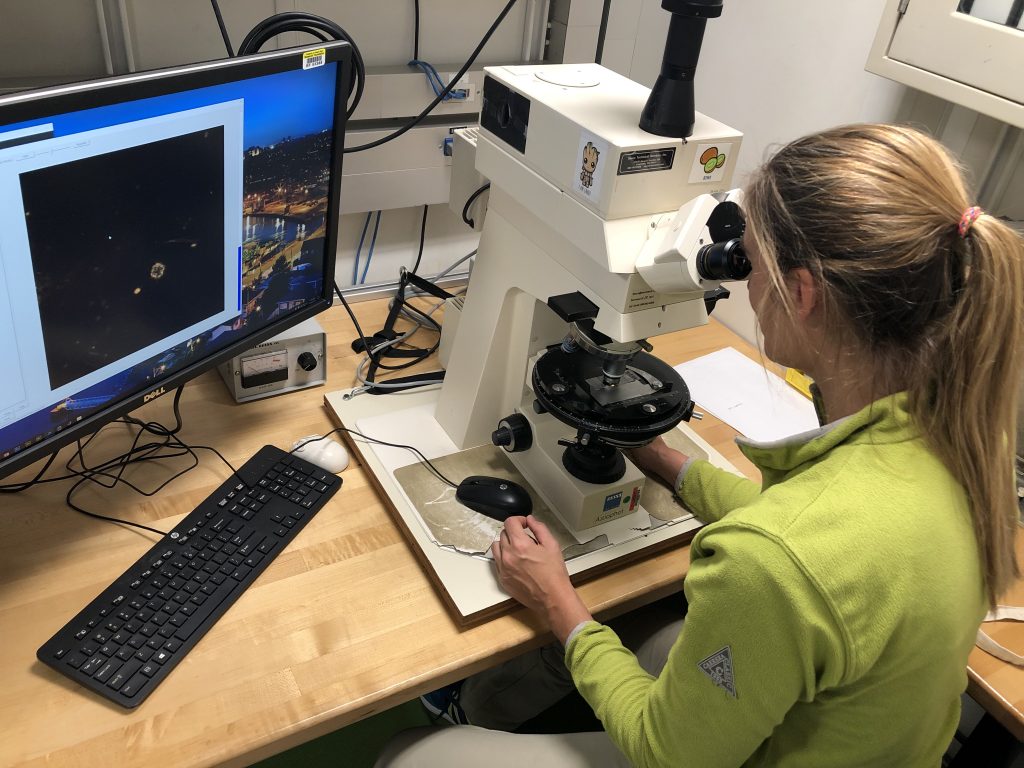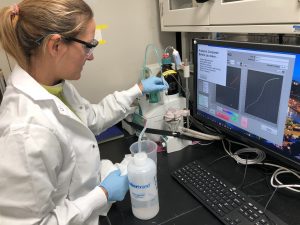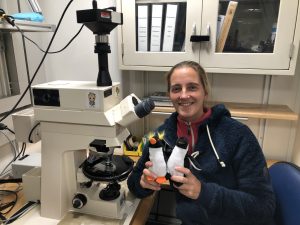
Career Spotlight: Micropaleontologist Elisa Malinverno

Elisa Malinverno Interview
Please describe your job duties while on the JR. What will you be doing on a daily basis?
-
-
-
-
-
-
-
-
- Nannofossil Biostratigraphy
-
-
-
-
-
-
-
Describe one instrument or tool that is essential for you to do your job? Or a piece of equipment on the JR that is useful and why – what does it do?
-
-
-
-
-
-
-
-
- I work with a light microscope at 1000x to identify calcareous nannofossils.
-
-
-
-
-
-
-
Why is your work (or research) important? What question are you trying to answer or how does your work/research help assist/advance scientific knowledge?
-
-
-
-
-
-
-
-
- Calcareous nannofossil biostratigraphy is one of the main ways to date the cores that we are collecting. I will then focus on calcareous-rich intervals in sediment cores that, in the Southern Ocean, correspond to warm climatic intervals and look at nannofossils as proxies for paleoproductivity. In the siliceous-rich intervals, I will also look at silicoflagellates as temperature proxies. The overall goal is to track the response of phytoplankton across different climatic cycles.
-
-
-
-
-
-
-

Why the ocean? What made you choose a career at sea or career that involves the ocean?
- I was fascinated by a video of an oceanographic cruise that my university professor was showing in class, so I signed up for an upcoming cruise and I was lucky enough to be taken onboard. That was in 1996 and the following year I was on-board again to get water samples for my master thesis on extant coccolithophores.
What are you most excited about for this expedition and/or being on the JR?
- JR is a unique opportunity to sample deep into the ocean sediments, something you cannot do with other vessels, and also, the working environment is amazing.
What are three things you think are needed for a successful expedition at sea? And Why!
- The big three: money, ideas, and people – not necessarily in this order, I think they are equally important.
If you could answer one question about our Earth – what would it be and why?
- The one question that fascinated me most when I was at school was how plate tectonics works, which is something unique to our planet.
What is your favorite sea creature and why?
- My favorite sea creature is the penguin. I even brought two toy penguins onboard with me to keep me company while working. I could not find my favorite one, though, the Emperor Penguin.

When did you know you wanted to pursue a career in science or an ocean science career?
- I knew I wanted an ocean science career since my first oceanographic cruise in 1996 aboard the Italian Oceanographic Navy Vessel Ammiraglio Magnaghi.
What do you personally hope to gain or experience while on EXP383?
- I hope to get great sediment cores, experience international collaboration, and end up with high-quality scientific results.
What message do you have for anyone considering a career at sea or a career involving the ocean sciences?
- You should go for it: if you really want to, anything is possible!
What do you do back home when not on the JR?
- I am an Associate Professor at the University of Milano-Bicocca, so my main tasks are teaching and doing research. I have 2 kids which take up the remaining time.
Do you get sea sick? If yes or sometimes, please also select the other tab and describe how you cope with it.
- No: I got sea sick on my first cruise and decided I would not be sea sick anymore – so I trained for that and it worked!
The need for space comes in many forms. Which type of space, in general, is the most important to you?
- ___Personal Space
- ___Creative Space
- ___Outdoor Space
- ___Emotional Space
- ___Physical Space
- ___Spiritual or Meditative
- ___Outer Space
- ___Community Space
- ___Quite Space
- ___Productive/Work Space
- ___Digital/Virtual Space
- ___Public Space
- _X_Inner Space
- ___Other:
Why that type of space? What makes it important to you and will it be available while on the JR?
- Inner space allows you to be with your thoughts, which is something that can take you back to yourself, your aims, and your own identity. I think it will be easily achieved on JR because everyone seems very respective of each other. But I think outdoor space is equally important, so I would select that too, and outdoor space onboard JR can be about being connected with nature, observing the sea and possibly sea life, smelling the air, feeling the cold wind, and looking at the dark sky.